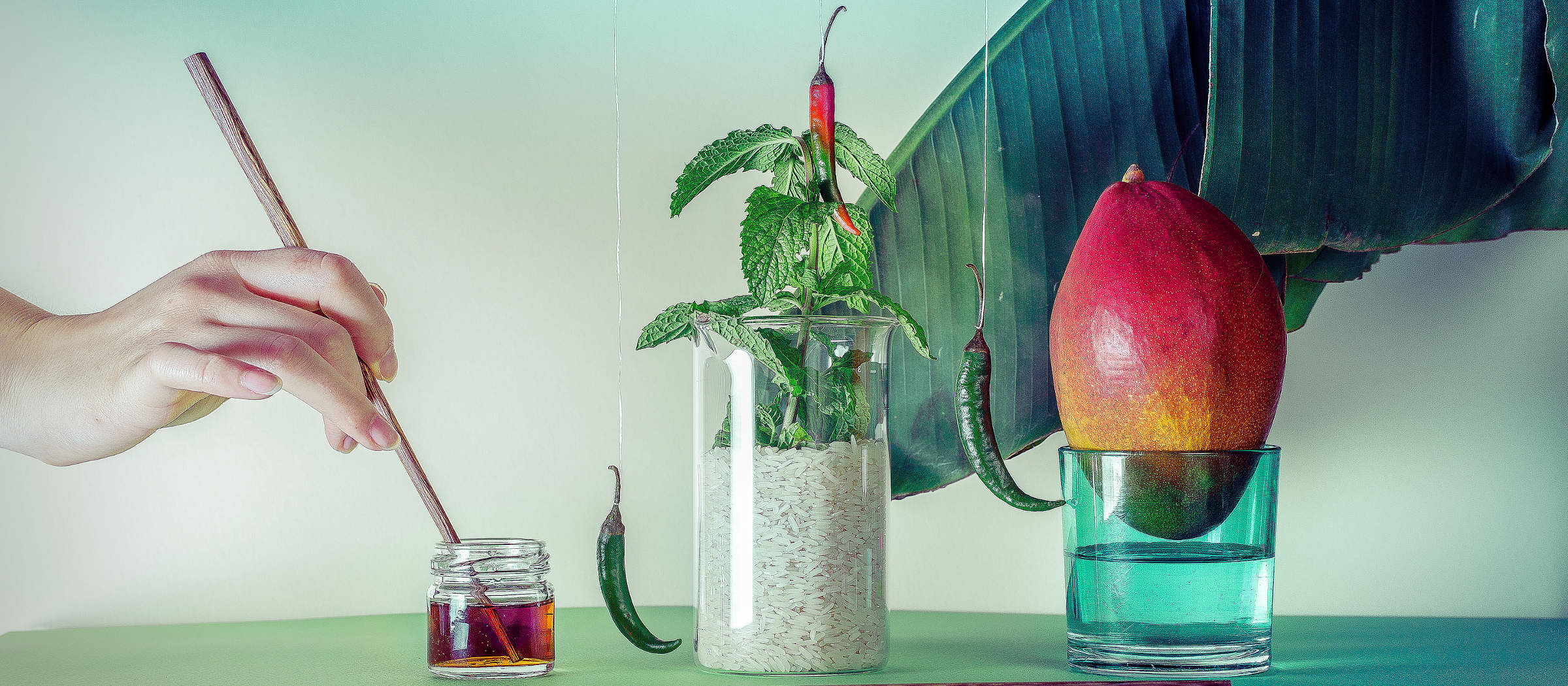The New Gastronome
Sugar, Spice, and Everything Rice
A Glimpse into Cambodia’s Khmer Cuisine
by Ashley Thuthao Keng Dam
by Ashley Thuthao Keng Dam

I remember the exact moment when I was first asked to explain what made “Khmer” or Cambodian food distinct from the rest of Southeast Asian cuisine. I was a first-year student, seated in my collegiate dining hall in the later hours of the morning, being confronted by a seemingly curious (yet, inadvertently, offensive) peer.
She adjusted her ponytail while she scanned through the upcoming lunchtime options, noting all of the adjusted-for-the-rural-Americana-palette options that would soon be available whilst making sure she added a sparse remark of interest or aversion. Naturally and more so, unfortunately, the topic of my ethnicity came up, which then evolved the brief conversation towards a focus on all things Khmer and/or Cambodian.
I explained the basics: geographical location, political history, famous tourist sites, and most importantly, the food. I became somewhat emotional, rustling up all of the fond memories I had eating lunches after Apsara (Cambodian ballet) rehearsals at Wat Khmai (the local Cambodian Buddhist temple), the army of aunties that cooked at every Cambodian family cookout I’ve ever been to, as well as the variety of simple Khmerican dishes my mother had put together over the years.
“Khmer cuisine is simultaneously complex, yet tremendously simple.”
To me, Khmer cuisine was exceptionally colourful; heavily demarcated by its extensive use of garlicky fish sauce, citrusy lemongrass, burning bird-eye chilis, and a spread of fermented elements across a collective of meats and vegetables. Khmer cuisine is simultaneously complex, yet tremendously simple. As I relayed this information to my peer, her brows demonstrated a mixture of confusion and intrigue. Upon the completion of my impassioned ode to Khmer cuisine, she smiled and said, with the utmost confidence: “So it’s basically Thai food, right?” No, Becky, it isn’t…and here’s why:
Nestled cosily between Vietnam and Thailand is Cambodia, whose tropical climate, watery rice-fields, and overgrown jungles house several (sometimes edible) relics of the former Khmer empire. Often acknowledged as the site of the religious monument of Angkor Wat, Cambodia’s eclectic cuisine, more often than not, is overlooked entirely. Within colloquial conceptions and perspectives, Cambodia and its cuisine have often been conflated with the food traditions of its neighbors.
Whether this confusion stems from ignorance or past associations concerning Indochina, is a debatable question. Regardless, the aforementioned anecdote is just one of many experiences demonstrating this misunderstanding — as short conversations with any of my Cambodian peers never fail to remind me.
A. D V. E. R. T. I. S. I. N. G
Due to vast ecological diversity and vulnerability at the mercy of seasonality, Cambodia’s two dozen or so provinces consume and prepare a plethora of different local eats and sweets. Unlike its neighbors, Cambodian cuisine takes advantage of a wide selection of protein staples which include, but are not limited to: various organ meats, rodents, insects, and arthropods. Whether simply roasted or incorporated into a stir-fry, curry, or noodle dish, these proteins gain further culinary dimension with the inclusion of locally procured spices.
With the Southwestern mountainous regions overflowing with wild Cardamom and the Tonle Sap region abundant with the rice-paddy herb known as Ma-om, these alimentary delights not only reflect unique landscape attributes, but also the specific foodways of the people that inhabit them. As French chef Joannès Rivière explains, Cambodian food is “first and foremost a cuisine of place”.

From pond frogs and river fish to edible flowers and foraged greens, Khmer cuisine showcases the idiosyncrasies of the landscapes in which each dish is prepared. Whether it’s Kampot Kadam (Kampot Pepper Crab) by the sea or Num Pao (steamed pork buns) in Phnom Penh, eating Khmer cuisine can be both an alimentary and ecological adventure within itself.
“At present, Khmer cuisine includes several adapted dishes, delineated from specialities of Vietnam, China, and Thailand, which are also very popular.”
In combination with the environmental fluxes, Cambodia’s sociocultural amalgam is the result of remnants of the Khmer Empire’s affinity for rice and the historical legacy of French imperialism. Across the centuries, many cultures have had a part in the composition of contemporary Khmer Cuisine.
At present, Khmer cuisine includes several adapted dishes, delineated from specialities of Vietnam, China, and Thailand, which are also very popular.
Piles of Num Pang sandwiches (similar to the Vietnamese banh mi) and bowls of the noodle-soup Kuy Teav (which has Chinese and Vietnamese origins) are breakfast and lunchtime constants. Khmer cuisine spends a lot of time playing with dichotomies; often highlighting the sweet, salty, spicy, sour, and bitter in a number of innovative ways.
Khmer cuisine similarly dabbles with textural contrasts; from sticky rice wrapped in banana leaves to crunchy fried prawns with shallots and Prahok (salted fermented fish paste), Khmer cuisine challenges diners to contemplate their experiences of taste and consistency on a case by case basis. Through blending iconic flavours from various regions in Southeast Asia, Khmer cuisine generates an entire food culture of its own that is teeming with a collective of unique conventions and novelties.
“Khmer food is neither typical of neighboring Thai or Vietnamese tastes; rather, it has its own nuanced selection of recurring ingredients with the occasional French or Chinese sensibilities.”
This interplay of intermingling food traditions and cultural exchanges led to the creation of a cuisine that is somewhere between “Oriental” and “Occidental”. On the fringes of the cultural palette tropes of “Thai sweet chili”, “Vietnamese herbality”, and the overtly idealised “French refinement” is where I mentally situate Khmer cuisine. I often receive inquiries along the lines of, “but how sweet?” and “but how spicy?” when it comes to describing Khmer food, which are questions I often find difficult to answer in full.
A. D. V. E. R. T. I. S. I. N. G.
To me, the reality of Khmer food and its experience is rooted in the subtle way in which it weaves the local with the global, the “Eastern” and the “Western”, as well as the historic with the modern. Khmer food is neither typical of neighboring Thai or Vietnamese tastes; rather, it has its own nuanced selection of recurring ingredients with the occasional French or Chinese sensibilities.
“Khmer food is incredibly sensorily stimulating; from the visual to the olfactory — it is astoundingly present.“
Khmer Cuisine embodies the rich influences of the numerous Thai, Chinese, Vietnamese, Indian, and French diasporas. Steaming bowls of Salaw Kari Sac Mon (chicken red curry) served with thick slices of freshly made baguette, a myriad of fried rice noodle dishes featuring crushed toasted peanuts and coconut milk, hearty Borbor (rice porridge) with a modge podge of intestinal organs, and creamy, savoury, spicy Amok (steamed curry custard) are just some examples of Khmer cuisine’s “greatest hits” which pay homage to these diverse origins. Khmer Cuisine’s capacity to unite elements from these aforementioned food cultures is but one way it separates itself from the Southeast Asian food paradigm.
Khmer food is incredibly sensorily stimulating; from the visual to the olfactory — it is astoundingly present. As a result, I’ve experienced my share of “Lunch box moments” and subsequent lunch-box-related anxieties growing up as a Khmer-American in the United States. As Anna Dao explains, lunch box moments are encapsulated in the “experience of cultural difference where food is involved as an object of fascination or derision”, meaning that although my American peers couldn’t exactly pinpoint what Khmer food consisted of, these knowledge gaps never inhibited them from categorising it as “Other”.
What composes a “meal” under Cambodian standards is dependent on whether rice (usually jasmine) is present or not. A salad of leafy greens and chicken would not make the cut, but somehow (perhaps unintuitively,) rice, a fried egg, and some teuk si-iw (soy sauce) reigned supreme under this schema. Cambodian people love rice; it’s their most important crop culturally, agriculturally, and economically, and is therefore served with nearly every single dish within reason.
In addition to this, most meals have some form of fresh herbs and or fruit to garnish as well as many types of dipping sauces (typically some rendition of teuk trey or fish sauce) to drizzle on. Juicy mangoes, refreshingly sweet watermelon, and crisp Bok Lahong (papaya salad) often accompany dishes rooted in aromatics of tamarind, ginger, palm sugar, sweet basil, kaffir lime leaves, cilantro, cloves, star anise, lemongrass, and many more. As a result of these culinary pillars of Khmer cuisine, my childhood lunches were sensorially overwhelming to many of my peers.
My classmates were unprepared to comprehend the wide array of unfamiliar food items that frequented my lunchbox; in contrast to their middle-class suburban morsels, my lunches were abnormal. Grilled fish with the head still on, mysterious pickles, and fermented seafood pastes didn’t necessarily blend into the lunchtime landscape of turkey and cheese sandwiches, fries, and greasy pizza slices I grew up in.
“Whilst I couldn’t envision it at the time, growing up with such a colourful food tradition and endless exposure to Khmer cuisine allowed me to truly explore its growing allure.”
In retrospect, I strongly believe that these moments were pivotal in galvanising my appreciation for Khmer food. Whilst I couldn’t envision it at the time, growing up with such a colourful food tradition and endless exposure to Khmer cuisine allowed me to truly explore its growing allure. Figuring out the novel characteristics and bonding over our shared failures in explaining what Khmer food really was to others (mostly non-Asian Americans) was just one way I recall bonding with other Khmer-American children.
All the days I’ve spent consuming an assortment of nameless wild(ish) greens, confusingly paired flavour combinations (tomato, bamboo shoots, and pineapple soup anyone?), and numerous stir-fried dishes suspiciously all referred to as solely Cha only helped me realise Khmer cuisine’s incomparable position within Southeast Asian cuisine.
Khmer food is a constantly evolving food narrative which grounds itself in circumstantiality; it exists as an intersection between the nation’s historical narrative and contemporary shifting ecologies. While it may share similarities with other Southeast Asian national cuisines with its inclusion of sugar, spice, and a never-ending amount of rice, it is, most certainly not, “basically Thai”.
Cover Image ©Aarón Gómez Figueroa.
Gallery photos: @lao_cambodianfood @yoca_tour @sweetyali87 @saintsofsunday
@tastyprahok @serenaprom @mangoraks_ @phnompenhnoodleshack @khmeranthem
@tastyprahok @momo_kitchen77 @khmerlifeofficial @tastyprahok @jm_hirsch
@pyzamadeinpoland @bycindyliu @siemreapnet @eunice.stories